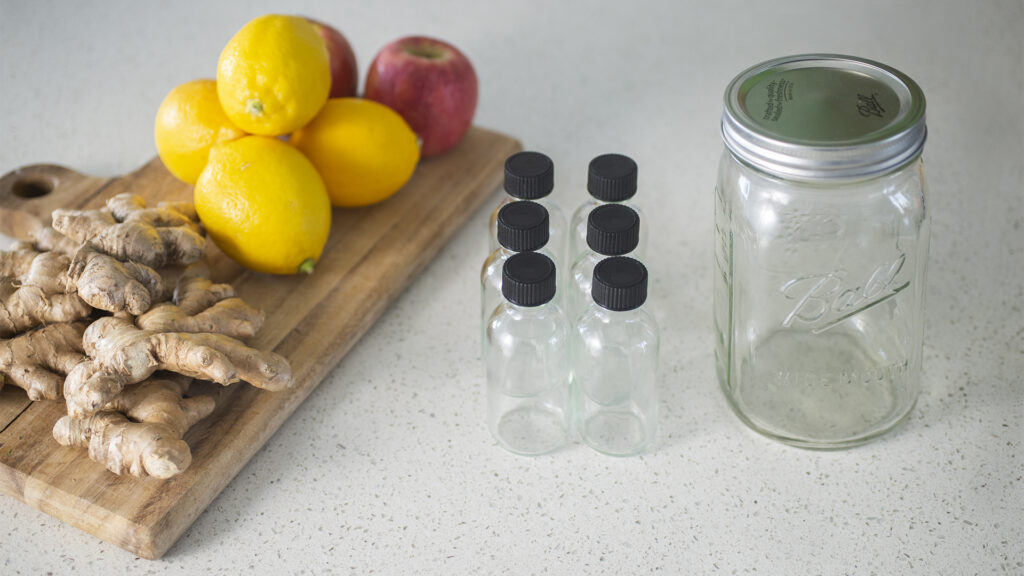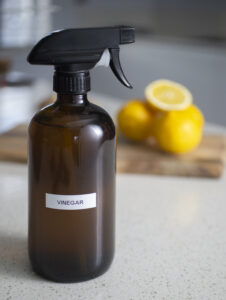
Let’s make ginger shots!
These small, concentrated drinks are made from fresh ginger root and they pack a punch of flavour and immune-boosting properties which make them the perfect thing to add to your diet during flu season or before travelling.
Ginger contains compounds that have antimicrobial properties, which means they can help fight against harmful bacteria and viruses that can weaken your immune system. It’s rich in antioxidants, which can help protect your cells from damage caused by harmful molecules known as free radicals. And, ginger’s anti-inflammatory compounds called gingerols and shogaols may help to reduce inflammation in the body and alleviate pain.
Its most well-known use is as a carminative, which means it soothes your digestive tract when you’re nauseated or after vomiting. So, ginger is pretty impressive. Ginger shots may also provide a burst of energy and help to improve your focus. And it was for this reason that I first started drinking these in my last year of nutrition school. I brought a large store-bought bottle into class and shared it around the next week you could see a line of ginger shots along the desks.
What’s in a ginger shot?
Ginger shots typically contain a blend of ginger, water, and sometimes other ingredients like lemon juice, coconut water or cayenne. However, it’s important to note that ginger shots can be really strong and they may cause some discomfort if consumed in large amounts or on an empty stomach, so it’s best to start with a small amount and see how your body reacts before drinking more.
Ginger shots can be purchased at many health food stores, juice bars, and cafes, but they can also be made at home with a juicer or blender. Here is a simple recipe to get you started.

How to make ginger shots
You’re going to need five large pieces of organic ginger, four unwaxed lemons, a couple of apples to add sweetness and water to dilute the mixture. You’ll also need some bottles to store the shots. I like using individual 60ml/2oz glass bottles that are already portioned out, or you can you any airtight mason jar.
I use a juicer with a citrus press for this recipe. If you don’t have a juicer, you can blend all of the ingredients along with 2-4 cups of water and use a nut milk bag to sieve out the pulp. You can also just use a grater on the ginger and apple and your hands to juice the lemon then add these to a pot with 2-4 cups of water and let it simmer for 10-15 minutes. When it’s cooled you can sieve it out like with the blender. Here’s a recipe for one shot made in a blender
Ingredients for one shot:
- 1-2 inches fresh organic ginger root
- 1/2 organic lemon (optional)
- 1/2 cup organic apple juice (optional)
- Pinch of cayenne pepper (optional)
- Water (if using a blender)
Instructions:
- Wash and peel the ginger root (you can keep the skin on if using organic ginger).
- Cut the ginger into small pieces and put them through a juicer. Alternatively, you can blend the ginger with a little bit of water in a blender, then strain the mixture through a fine mesh sieve or cheesecloth to remove any pulp.
- If using a lemon, juice half of it and add it to the ginger juice. You can also add a half cup of apple juice or the juice of 1/2 an apple and a pinch of cayenne pepper to taste.
- Stir or shake the ginger shot well to combine the ingredients.
- Drink the ginger shot immediately for the best results.
THESE BOTTLES WORK A TREAT AND THEY CUT DOWN ON SINGLE-USE PLASTIC
Juices tend to oxidise as soon as you make them so if you’re going for a large batch, it’s best to keep it in an air-tight container. If I’m not putting them into small bottles, I’ll use a mason jar and my food saver with a special attachment to suck all the air out. Juices will last much longer this way. I’ve seen versions where you have a hand pump that would work too. Otherwise, you can make smaller batches to ensure that you’re getting the most out of your vegetables.
Note: Ginger shots are potent and have a strong flavour, so it’s a good idea to start with a small amount of ginger and adjust the recipe to your taste preferences. It’s also a good idea to consult with a healthcare provider before adding any new food or supplement to your diet. If organic is not within your budget, you can soak your ingredients in a mixture of water and white vinegar using a ratio of 3 parts water to 1 part vinegar for 15 to 20 minutes, then rinse them with clean water. Another method is to mix baking soda with water to make a paste. Apply the paste to the vegetables and let them sit for 5 to 10 minutes. Then rinse with clean water.
If you make your own ginger shots, let me know over on Instagram ☺️
Watch the video here
Extra Information + Tips
Don’t throw away the pulp
The ginger pulp can be repurposed in a number of ways, depending on the extra ingredients you add to your shot. Here are a few ideas:
- Add it to smoothies: You can blend the pulp into smoothies to add fibre and extra nutrients.
- Make soups or broths: You can add pulp to soups or broths for added flavour and nutrition.
- Use it in baking: You can use the pulp in baking recipes, such as muffins, bread, or even ginger cakes.
- Make vegetable burgers or fritters: You can use the pulp to make burgers or fritters.
- Compost it: If you have a compost bin, you can add the pulp to it. It will decompose over time and provide nutrients to your garden.
- Freeze it for later use: If you’re unsure what to do with the pulp right away, you can freeze it for later use. Just make sure to label it with the date and what it is, so you don’t forget!
- Dehydrate it: You can add a few more ingredients to the pulp and roll it out on a sheet popping it in your oven at a low temp or a dehydrator to make ginger crackers, which you can then serve with hummus.
These are just a few ideas, but it’s a great way to reduce food waste and make the most of your produce, but don’t throw out the lemon peels either.
Save your lemon peels 🍋

Citrus peels are often thrown away after juicing, but they can actually be used in a variety of ways. Here are some ideas:
- Flavouring: The zest of citrus peels can be used to flavour dishes, baked goods, and cocktails. You can use a zester or a grater to remove the outer layer of the peel (avoiding the white pith which is bitter). The zest can be added to salads, marinades, dressings, and other dishes for a citrusy kick.
- Infusions: Citrus peels can also be used to make infusions, which can be used for teas, syrups, and other beverages. Simply steep the peels in hot water or add them to sugar and water to make a simple syrup. You can add herbs and other flavours to create your own unique blends.
- Cleaning: Citrus peels can be used to clean and deodorise your home. You can add the peels to vinegar and use the solution to clean surfaces such as countertops, sinks, and toilets. The citrus oils will help cut through grease and grime and leave a fresh scent.
- Potpourri: Citrus peels can also be dried and used in potpourri. You can add other dried herbs and flowers to create your own blends. Simply place the mixture in a bowl or sachet and enjoy the fresh scent.
- Cooking: Citrus peels can be candied and used as a garnish for desserts. You can also use the peels to make marmalade or chutney. Additionally, you can use the peels as a base for homemade broth or stock.
These are just a few ideas for using citrus peels. Get creative and experiment to find the uses that work best for you!
Who should avoid ginger shots?
While ginger is generally considered safe for most people when consumed in moderate amounts, there are certain situations in which ginger should be avoided or used with caution. If you have the following conditions, please speak to your healthcare provider or nutritional therapist before consuming ginger or avoid it altogether:
- Bleeding disorders: Ginger can increase the risk of bleeding, so individuals with bleeding disorders or who are taking blood-thinning medications should be cautious with ginger consumption.
- Diabetes: Ginger can lower blood sugar levels, so people with diabetes who are taking medications to lower blood sugar levels should monitor their blood sugar levels closely and speak with their healthcare provider before using ginger.
- Gallstones: Ginger can increase the production of bile, which may exacerbate symptoms in people with gallstones.
- Pregnancy: While ginger is generally considered safe for pregnant women when consumed in moderate amounts, high doses of ginger may increase the risk of miscarriage.
- Heart conditions: Ginger may interfere with medications used to treat heart conditions, so individuals with heart conditions should speak with their healthcare provider before using ginger.
- Allergies: Individuals with known allergies to ginger or other members of the Zingiberaceae family (which includes turmeric and cardamom) should avoid ginger.
As with any dietary supplement, it is important to speak with a healthcare provider or nutritional therapist before using ginger, especially if you have any underlying health conditions or are taking medications.



